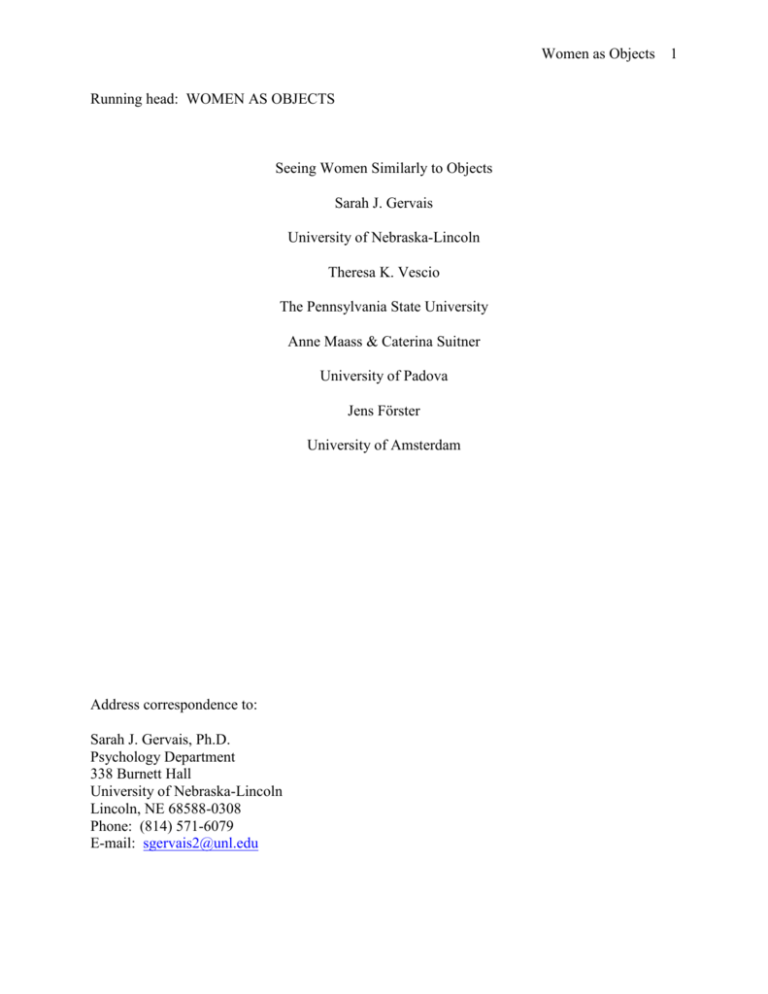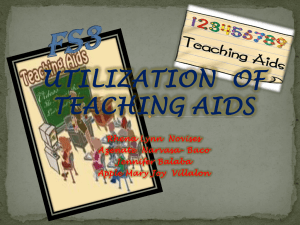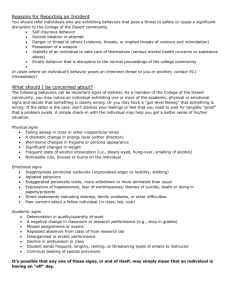
Women as Objects
Running head: WOMEN AS OBJECTS
Seeing Women Similarly to Objects
Sarah J. Gervais
University of Nebraska-Lincoln
Theresa K. Vescio
The Pennsylvania State University
Anne Maass & Caterina Suitner
University of Padova
Jens Förster
University of Amsterdam
Address correspondence to:
Sarah J. Gervais, Ph.D.
Psychology Department
338 Burnett Hall
University of Nebraska-Lincoln
Lincoln, NE 68588-0308
Phone: (814) 571-6079
E-mail: sgervais2@unl.edu
1
Women as Objects
2
Seeing Women Similarly to Objects
Treating a person as little more than an object, in its cognitive dimension, implies
acknowledging no significant differences between such a person and an ordinary,
everyday object.
– Lorraine Code (1995, p. 88)
People and objects clearly differ in several regards. People, for example, are assumed to
have internal desires, motives, emotions, goals, and agency, whereas objects are not (Buber,
1958; Fiske & Taylor, 1991; Ostrom, 1984). Consistent with this notion, scholars have shown
that different processes underlie the recognition of people compared to objects (Reed, Stone,
Grubb, & McGoldrick, 2006; Seitz, 2002; Tanaka & Farah, 1993, but see also Gauthier & Tarr,
1997). Others, however, have suggested that people may be seen similarly to objects, or may be
objectified (Haslam, 2006; Fredrickson & Roberts, 1997; MacKinnon, 1987; 2006; Nussbaum,
1999). In this work, we examine whether people are sometimes recognized similarly to objects
rather than persons.
One well-documented way that object recognition differs from person recognition is that
whole objects are recognized similarly to parts of objects, whereas whole people are recognized
better than parts of people (Tanaka & Farah, 1993; Seitz, 2002; see also Reed, et al., 2006). This
reasoning has been applied to the comparison of both faces and objects (e.g., Tanaka & Farah)
and bodies and objects (Seitz; Reed et al.).1 For example, a whole house is recognized similarly
to a door from the house, whereas a whole person or face is recognized better than an arm or eye
from the person. When, however, might people be recognized similarly to objects?
Across disciplines, scholars have argued that people may be objectified. In medicine, for
example, physicians may objectify patients and separate the symptoms from the whole person
(e.g., Barnard, 2001 Foucault, 1989). Economists and philosophers have argued that in
capitalism, employees’ work qualities are separated from their whole person (e.g., Marx, 1867).
Women as Objects
3
To the employer, the employee is an instrument; the sum total of the employee is the workrelated capabilities (Gruenfeld, Inesi, Magee & Galinsky, 2008). Psychologists have argued that
people from high status social groups (e.g., Whites and men) may objectify people from low
status social groups (e.g., racial minorities and women, Haslam, 2006). Perhaps most
convincingly, feminist scholars have argued that women, in particular, are sexually objectified
(Code, 1995; Fredrickson & Roberts, 1997; MacKinnon, 1987; Nussbaum, 1999), or women are
reduced to their sexual body parts.
Several findings are consistent with the notion that women are sexually objectified.
Visual representations of women, for example, often show the camera lens directed toward the
sexual body parts, rather than the faces or whole bodies of women (Archer, Iritani, Kimes &
Barrios, 1983). Women report being sexually objectified by others (Kozee, Tylka, AugustusHorvath, & Denchik, 2007; Moradi, Dirks & Matteson, 2005; Swim, Hyers, Cohen, & Ferguson,
2001) and women’s sexual appearance is often regarded as more important than other attributes
both by women themselves (Fredrickson & Roberts, 1997; Noll & Fredrickson, 1998) and other
people (Gurung & Chrouser, 2007; Strelan & Hargreaves, 2005). In sum, it is clear that women
are sexually objectified by the media, themselves, and other people. What is unclear, however, is
the perceptual consequences of viewing people as sexual objects.
We suggest that one consequence of women being sexually objectified by the media,
themselves, and other people, is that perceivers may recognize women similarly to objects. If
women are indeed reduced to their sexual body parts, then just as a door to a house is recognized
as well as the whole house, the sexual body parts (e.g., waists or breasts) of a woman may be
recognized as well as the whole woman.
When are Women Objectified?
Women as Objects
4
Importantly, women are not reduced to their sexual body parts across all situations or by
all people. The sexual objectification of female athletes, for example, varies across situations
and people. When a female swimmer breaks the Olympic world record, people most likely
consider her athletic abilities, but when that same female swimmer appears in a bikini in Sports
Illustrated, people may reduce her to her sexual body parts. Similarly, though the readers of
Sports Illustrated may reduce the swimmer to her sexual body parts, it is unlikely that her close
family and friends, who have more access to her thoughts, feelings and aspirations, reduce her to
her sexual body parts.
We suggest that women will be recognized similarly to objects when features of the
situation or the perceiver makes her sexual body parts salient, whereas women will be
recognized similarly to persons when features of the situation or perceiver make her whole
person salient. This rationale formed the basis of three experiments that examined when women
and men were recognized similarly to objects versus persons.
One situation in which the sexual body parts may be salient is when people experience
gender identity threat. Gender identity threat is often elicited when people learn that they lack
critical features on sex-relevant dimensions (Branscombe, Ellemers, Spears & Doosje, 1999) and
has been linked to sexually objectifying behaviors, like sexual harassment (Maass, Cadinu,
Guarnieri & Grasselli, 2004). Why might women be recognized similarly to objects when
perceivers experience gender threat?
Generally speaking, threat is associated with narrowed attention and memory (cite). At
the very least, narrowed processing, may be related to focusing on the parts of a person, rather
than the whole person. Furthermore, threat tends to make threat-related stimuli particularly
salient. Under threat, for example, people with spider phobias tended to focus on spider stimuli,
Women as Objects
5
ignoring other aspects of the situation (Wessel & Merckelbach, 1998). Because gender threat
makes gender-relevant features salient, the gender parts of others may be especially memoryworthy.
Two competing predictions follow from this rationale. On the one hand, it is possible
that gender threat leads to more recognition of sexual body parts in general. If this is the case,
when gender threat is high, then women’s and men’s sexual body parts may be recognized
equally to whole bodies. On the other hand, however, we have argued that because women are
sexually objectified by the media, themselves, and other people, that women are more likely than
men to be recognized as sexual objects.
Integrating these considerations, we hypothesized that when gender threat was high,
women would be recognized similarly to objects and men would be recognized similarly to
persons, whereas when gender threat was low, women and men would be recognized similarly to
persons. More specifically, we tested whether women’s whole bodies and body parts were
similarly recognized when gender threat was high, but not low in Experiment 2.
One implication of our suggestion, however, is that women will be recognized similarly
to objects whenever their body parts are salient, even in situations that are not explicitly linked to
gender or objectification, per se. Stated differently, if our suggestion that women are recognized
similarly to objects when the parts, rather than whole women are salient, then even subtle
situational or individual difference features that focus attention and memory on parts, rather than
wholes, may lead women to be recognized similarly to objects.
One such situation is when stimuli are processed locally versus globally. Focusing on
global rather than local stimuli is typically the dominant, accessible strategy (Navon, 1977; see
also Fiske & Taylor, 1991; Kimchi, 1992). For example, people tend to focus on the forest,
Women as Objects
6
rather than the trees. People do, however, focus on local stimuli in a variety of situations that are
unrelated to gender. Under conditions of general threat, for example, the dominant strategy is
processing local stimuli (Mogg, Mathews, Bird & Macgregor-Morris, 1990) particularly when
people are high in trait anxiety (Derryberry & Reed, 1998). Similarly, people in sad moods tend
to process local stimuli more than global stimuli (Gasper & Clore, 2002).
It is possible that like threat and sad moods, that local processing objectives make the
parts of stimuli salient. Under conditions of local processing, the body parts of women and men
may be memory-worthy. We suggest, however, that because women are sexually objectified by
the media, themselves, and other people, only women will be reduced to their sexual body parts
under local processing objectives.
Integrating these considerations, we hypothesized that when local processing objectives
were salient, women would be recognized similarly to objects and men would be recognized
similarly to persons, whereas when global processing objectives were salient, women and men
and would be recognized similarly to persons. More specifically, we tested whether women’s
whole bodies and body parts were recognized similarly when local processing objectives were
salient, but not when global processing objectives were salient in Experiment 3.
Overview of the Present Work
To examine these hypotheses, we presented images of men and women and examined
whether women were recognized similarly to objects. Specifically, participants completed body
versus object recognition tests (modified from Tanaka & Farah, 1993 and Seitz, 2002) when
gender identity threat was high or low in Experiment 2 and when local or global processing
objectives were salient in Experiment 3.
Experiment 1
Women as Objects
7
Method
Participants, Design, and Predictions
Seventy-three undergraduates (45 females, 38 males) participated for course credit.
Participants worked at computers to complete the experiment, which used a target gender (male
or female) X type of recognition task (body parts or whole body) X participant gender (male or
female) mixed model experimental design. Target gender and type of recognition task were
within-participant factors. Participant gender was a between-participant factor. We
hypothesized that women’s whole bodies would be recognized similarly to body parts, whereas
men’s whole bodies would be recognized better than body parts, as evidenced by a target gender
X type of recognition task interaction.
Procedure
After providing informed consent, participants completed parts versus whole recognition
tasks adapted from Tanaka and Farah (1993) and Seitz (2002). Participants saw 48 full body
images of White college-aged men and women presented in random order. Specifically, a person
was shown from head to knee, in a standing position, with eyes focused on the camera. Clothing
style and facial expression were controlled; each person wore blue jeans and a white tank top and
had a neutral facial expression.
Add pixel information.
On each trial, an image of a man or a woman appeared in the middle of the computer
screen for 5 seconds. A blank screen then appeared for 1 second prior to the recognition task.
In the recognition task, participants were presented with two images, one of the left of the screen
and one on the right of the screen. One of the images was unmodified and contained the original
image and the other image was the original image in which a body part (waist or chest) had been
slightly modified. Participants were asked to indicate which one of the two images matched the
Women as Objects
8
previously seen image with an appropriate key press. Half the trials included a whole body
recognition task, in which the original whole body image and a slightly modified version of the
original whole body image appeared. The other half of the trials included a body parts
recognition task, in which a body part from the original body and a slightly modified body part
appeared.
Participants completed 12 practice trials before completing 48 experimental trials. Trials
were created by crossing target gender and type of recognition task. Specifically, twenty-four
male and twenty-four female targets were presented. Of the male and female targets, half were
whole body recognition tasks and half were body parts recognition tasks. The number of correct
responses within each condition was divided by the total number of trials within that condition to
create mean accuracy scores. Thus, each participant received four mean accuracy scores for
trials involving the recognition of women’s whole bodies, women’s body parts, men’s whole
bodies, and men’s body parts. If participants remembered women similarly to objects, women’s
whole bodies should be remembered similarly to women’s body parts, whereas men’s whole
bodies should be remembered better than women’s body parts.
Results and Discussion
Mean accuracy scores were submitted to a target gender (male or female) X type of
recognition (body parts or whole body) X participant gender (male or female) mixed-model
Analysis of Variance (ANOVA). Two significant effects emerged from this analysis. A main
effect of participant gender F(1, 81)=6.55, p<.02, ηp2=.08 revealed more recognition for female
participants (M=.61, SD=.09) than male participants (M=.55, SD=.10). This effect was, however,
qualified by the predicted target gender X type of recognition interaction, F(1, 81)=5.32, p<.03,
ηp2=.05. As Figure 1 shows, for male targets, whole bodies (M=.60, SD=.20) were recognized
Women as Objects
9
better than body parts (M=.55, SD=.21), F(1, 81)=3.20, p<.05, ηp2=.05, whereas for female
targets, body parts (M=.62, SD=.21) were recognized (marginally) better than whole bodies
(M=.56, SD=.20), F(1, 81)=2.68, p<.0789, ηp2=.03.
The pattern of recognition for men replicated previous findings (Tanaka & Farah, 1993;
Seitz, 2002). Participants recognized men’s whole bodies better than men’s body parts. By
contrast, a very different pattern of findings emerged in the recognition of women. Participants
similarly recognized women’s body parts and women’s whole bodies. Though previous
researchers have not examined the recognition of women, why might the pattern of recognition
differ for men and women, such that men’s whole bodies are recognized more than men’s body
parts, but women’s body parts are recognized better than women’s whole bodies? We suggest
women are recognized similarly to objects when the sexual body parts of women are salient. We
initially tested this suggestion in Experiment 2 by having participants complete the recognition
tasks under conditions when sexual body parts should be more salient (i.e., high gender threat)
and when sexual body parts should be less salient (low gender threat).
Experiment 2
To examine why women are recognized similarly to objects, whereas men are recognized
similarly to persons, we added an individual difference variable to the design used in Experiment
1. More specifically, male and female students were randomly assigned to a high gender threat
or low gender threat condition, prior to completing the computer recognition tasks of Experiment
1. We predicted that women would be recognized similarly to objects when gender threat was
high, but not low and that men would be recognized similarly to persons, regardless of gender
threat.
Method
Women as Objects 10
Participants, Design, and Predictions
One hundred and forty-three undergraduates (67 females, 76 males) participated for
course credit. This experiment used a target gender (male or female) X type of recognition task
(parts or whole) X participant gender (male or female) X gender threat (high or low) mixed
model experimental design. Target gender and type of recognition task were within-participant
factors. Participant gender and gender threat were between-participant factors. We hypothesized
that women’s whole bodies would be recognized similarly to body parts, whereas men’s whole
bodies would be recognized better than body parts when gender threat was high, but not low, as
evidenced by a significant target gender X type of recognition task X gender threat interaction.
Procedure
The procedure was identical to that used in Experiment 1 with one exception. Prior to
completing the computer task, participants completed the Bem Sex Role Inventory (BSRI) and
received feedback about their scores. Feedback about BSRI scores was manipulated to threaten
or assuage gender threat. In the high gender threat condition, participants learned that their
responses to the BSRI were similar to responses provided by the opposite gender participants. In
the low gender threat condition, participants learned that their responses to the BSRI were
similar to responses provided by same gender participants.
Results and Discussion
Mean accuracy scores were submitted to a target gender (male or female) X type of
recognition task (part or whole body) X participant gender (male or female) X gender threat
(high or low) mixed-model ANOVA. Target gender and type of recognition were within
participants factors in this analysis. Participant gender and gender threat were between
participants factors. Three significant effects emerged from this analysis.
Women as Objects 11
The first two findings replicated the findings of Experiment 1. A main effect of
participant gender F(1, 139)=7.70, p<.0065, ηp2=.06, revealed more accurate recognition for
female participants (M=.64, SD=.11) than male participants (M=.57, SD=.11).
Again, this effect was qualified by the predicted target gender X type of recognition
interaction, F(1, 124)=6.30, p<.0135, ηp2=.05, revealing that for male targets, whole bodies
(M=.61, SD=.19) were recognized (marginally) better than body parts (M=.57, SD=.21), F(1,
81)=3.19, p<.0764, ηp2=.02, whereas for female targets, body parts (M=.63, SD=.22) were
recognized similarly to whole bodies (M=.59, SD=.20), F(1, 81)=1.85, p<.1757, ηp2=.01.
Importantly, the main effect of participant gender and the interaction with type of
recognition task were moderated by gender threat, as evidenced by the predicted three-way
interaction between target gender, type of recognition task, and gender threat, F(1, 124)=5.68,
p<.0188, ηp2=.04. As the left side of Figure 2 shows, in the low threat condition, no significant
effects emerged, Fs<2.01, but as the right half of Figure 2 shows, in the high threat condition,
participants recognized men similarly to persons, whereas participants recognized women more
similarly to objects. Specifically, in the high threat condition, whole bodies of male targets
(M=.65, SD=.20) were recognized better than body parts of male targets (M=.57, SD=.19), F(1,
124)=5.97, p<.0179, ηp2=.10. Additionally, body parts of female targets (M=.66, SD=.22) were
recognized better than the whole bodies of female targets (M=.57, SD=.20), F(1, 124)=5.33,
p<.0249, ηp2=.09.
Experiment 2 was designed to test the prediction that women (vs. men) are recognized
similarly to objects when gender identity is threatened. Extending previous research on gender
threat (e.g., Maass et al., 2004), Experiment 2 suggests that gender identity threat may influence
recognition processes that underlie objectifying behavior. Furthermore, it provides evidence for
Women as Objects 12
our suggestion that seeing women similarly to objects is particularly likely when sexual body
parts are salient. We further tested this suggestion in Experiment 3 by having participants
complete the recognition tasks under conditions that would make body parts salient, but that was
not directly related to gender, threat, or objectification. Specifically, we examined the
recognition of men and women when sexual body parts should be more salient (i.e., local
processing objectives) and when sexual body parts should be less salient (global processing
objectives).
Experiment 3
To examine why women are recognized similarly to objects, whereas men are recognized
similarly to persons, we added a different individual difference variable to the design used in
Experiment 2. More specifically, male and female students were randomly assigned to a global
processing or local processing objective condition, prior to completing the computer recognition
tasks of Experiment 1. We predicted that women would be recognized similarly to objects under
local, but not global processing objectives and that men would be recognized similarly to
persons, regardless of processing objective.
Method
Participants, Design, and Predictions
One hundred and forty-four undergraduates (72 females, 72 males) participated for
course credit. This experiment used a target gender (male or female) X type of recognition task
(parts or whole) X participant gender (male or female) X type of processing (global or local)
mixed model experimental design. Target gender and type of recognition task were withinparticipant factors. Participant gender and type of processing were between-participant factors.
We hypothesized that women’s whole bodies would be recognized similarly to body parts,
Women as Objects 13
whereas men’s whole bodies would be recognized better than body parts under local, but not
global processing objectives, as evidenced by a significant target gender X type of recognition
task X type of processing interaction.
Procedure
The procedure was identical to that used in Experiment 1 with one exception. Prior to
completing the computer task, participants completed an identification task in which either local
or global processing objectives were introduced. Specifically, participants were presented with
16 trials in which a global letter (e.g., a large letter H) appeared on a computer screen. The
horizontal or vertical lines making up the global letter was formed from five identical closely
spaced local letters (e.g., several small letter Fs). The targets included four global Hs, Fs, Ls,
and Ts. Each global target included local Hs, Fs, Ls, or Ts one time (e.g., in one instance a
global H included local Fs; in another instance a global H included local Hs). Participants in the
local condition were asked to indicate the local letter across trials. Participants in the global
condition were asked to indicate the global letter across trials.
Results and Discussion
Mean accuracy scores were submitted to a target gender (male or female) X type of
recognition task (parts or whole body) X participant gender (male or female) X type of
processing (global or local) mixed-model ANOVA. Replicating the findings of Experiment 1
and Experiment 2, a significant target gender X type of recognition interaction emerged, F(1,
140)=8.01, p<.0054, ηp2=.05. Again, for male targets, whole bodies (M=.61, SD=.21) were
recognized better than body parts (M=.54, SD=.21), F(1, 81)=10.34, p<.00017, ηp2=.07, whereas
for female targets, body parts (M=.62, SD=.21) were recognized similarly to whole bodies
(M=.59, SD=.21), F(1, 81)=1.57, p<.2124, ηp2=.01.
Women as Objects 14
Importantly, however, this effect was qualified by processing goal as evidenced by a
significant target gender X type of recognition X processing goal interaction, F(1, 140)=3.98,
p<.0481, ηp2=.03. As the right half of Figure 3 shows, in the local condition, male whole bodies
(M=.61, SD=.20) were recognized better than male body parts (M=.51, SD=.20), F(1, 81)=8.16,
p<.0055, ηp2=.10, whereas female body parts (M=.65, SD=.22) were recognized better than
female whole bodies (M=.57, SD=.21), F(1, 81)=4.89, p<.0301, ηp2=.06. However, as the left
half of Figure 3 shows, no significant emerged in the global condition, Fs<2.49 (p<.1191 for
male parts vs. male whole).
Experiment 3 was designed to test the prediction that women (vs. men) would be
recognized similarly to objects under local (vs. global) processing objectives. Experiment 3
provides further evidence that women will be recognized similarly to objects when sexual body
parts are salient. The results from Experiment 3 suggest that even subtle situational features, that
on the surface seem unrelated to gender, threat, or objectification, may lead women to be seen
similarly to objects.
General Discussion
Findings from Experiments 1-3 suggest that women are perceived similarly to objects.
These results have important theoretical and practical implications. To our knowledge, the
studies reported here are the first to examine whether people may sometimes be recognized
similarly to objects and to examine the perceptual consequences of the sexual objectification of
women by the media, themselves, and other people. Consistent with theories of face/body vs.
object recognition, men’s bodies were recognized more than men’s body parts. Consistent with
our extension of objectification theory, however, women’s body parts were recognized similarly
than women’s whole bodies across three experiments. Furthermore, the findings from
Women as Objects 15
Experiment 2 and 3 provide evidence for our suggestion that women, but not men are viewed
similarly to objects when sexual body parts are directly (as in the case of gender identity threat),
but also indirectly (as is the case with local and global processing goals) relevant to the situation.
When recognized similarly to objects, women’s sexual body parts may not only be
recognized, but women also be assumed to have other object qualities (e.g., to be fungible with
other women, to lack autonomy and subjectivity, Nussbuam, 1999). This work may also be
extended to consider the objectification of people from other low status, socially meaningful
groups, like racial minorities, people with disabilities, gay men and lesbians and the elderly, but
also workers and patients.
Women as Objects 16
References
Buber, M. (1958). I and Thou. New York, NY: Scribner.
Code, L. (1995). Rhetorical spaces: Essays on gendered locations. Routledge, New
York, NY.
Fiske, S. T. & Taylor, S. E. (1991). Social cognition (2nd ed.). New York, NY, England:
Mcgraw-Hill Book Company.
Forster & Higgins (2005)
Gervais, S. J. & Vescio, T. K. (2008). Perceiving people as fungible objects : The role of
gender and stereotypicality. Manuscript in preparation.
Gasper, K (2004)
Haslam, N. (2006). Dehumanization: An integrative review. Personality and Social Psychology
Review, 10(3), 252-264.
Maass, Cadinu, Guarnieri, and Grasselli (2004)
Nussbaum, M. C. (1999). Sex and social justice. Oxford, England: Oxford University Press.
Ostrom, T. M. (1984). The sovereignty of social cognition. In Wyer, R. S, & Srull, T. K.
(Eds.) The Handbook of Social Cognition, Vol 1: Basic Processes, 2nd Edition, (pp. 1 –
37). Hillsdale, NJ: Lawrence Erlbaum Associates
Reed, C. L., Stone, V. E., Grubb, J. D., & McGoldrick, J. E. (2006). Turning configural
processing upside down: Part and whole body postures. Journal of Experimental
Psychology: Human Perception and Performance, 32(1), 73-87.
Seitz, K. (2002) Parts and wholes in person recognition: Developmental trends.
Journal of Experimental Child Psychology, 82(4), 367-381.
Tanaka, J. W. & Farah, M. J. (1993). Parts and wholes in face recognition. The Quarterly
Journal of Experimental Psychology, 46A(2), 225-245.
Women as Objects 17
Figure Captions
Figure 1. Percentage correct as a function of target gender and type of recognition.
Figure 2. Percentage correct as a function of target gender, type of recognition, and gender
identity threat.
Figure 3. Percentage of correct as a function of target gender, type of recognition, and
processing objective.
Women as Objects 18
Percentage Correct
0.66
0.61
Female
Male
0.56
0.51
0.46
Part
Whole
Type of Recognition
Percentage Correct
Women as Objects 19
0.66
0.61
Female
Male
0.56
0.51
0.46
Parts
Whole
Parts
Low Threat
Whole
High threat
Type of Recognition
Percentage Correct
Women as Objects 20
0.66
0.61
Female
Male
0.56
0.51
0.46
Part
Whole
Part
Global
Whole
Local
Type of Recognition
Women as Objects 21
1
Explanations for differences in person and object recognition have long been debated in the
discipline of cognitive psychology. Broadly, the debate asked whether the recognition of
persons (particularly faces) is unique or qualitatively different than the recognition of objects.
Some have argued that differences in object recognition are found because of differences in
expertise (humans are all assumed to be experts at person recognition). Thus, experts at certain
objects (e.g., dog show judges) should perceive those objects (dogs) similarly to persons. This
debate has recently been extended through cognitive neuroscience. Object and person
recognition appear to be associated with different regions of the brain. Person recognition is
associated with activity in the extrastriate body area of the right lateral occipitotemporal cortex,
whereas object recognition is more generally associated with activity in the lateral occipital
complex (Downing, Jiang, Shuman, & Kanwisher, 2003, but see also Gauthier & Tarr, 1997).
Although important and critical to a full understanding of recognizing women similarly to
objects, this debate is beyond the scope of this initial inquiry into the recognition of men and
women.









